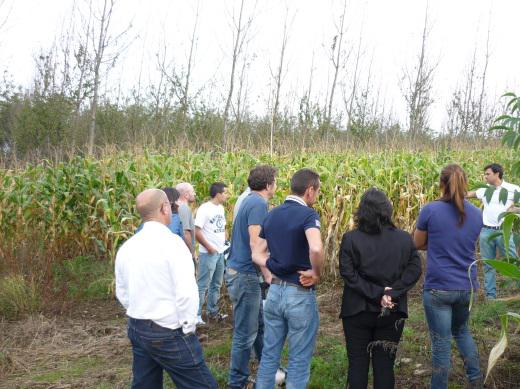
Sistemas silvoaráveis em Espanha
Descrição do sistema
Na Galiza, no noroeste de Espanha, a empresa “Bosques Naturales“ está a conduzir experiências em sistemas silvoaráveis com clones de nogueiras (Juglans spp) e milho (Zea mays).
Reunião de stakeholders inicial
Uma reunião inicial de stakeholders, com 14 participantes, foi realizada a 21 de outubro de 2014. Os aspectos mais positivos dos sistemas silvoaráveis salientados foram as oportunidades de negócios, a originalidade e interesse, a viabilidade do projeto, a diversidade de produtos e os benefícios ambientais. Os aspectos negativos prendem-se com a complexidade do trabalho, os custos do trabalho e da gestão e as perdas devidas a animais selvagens. A integração de árvores, milho e produção de plantas medicinais e questões de protecção das árvore de animais foram identificados como áreas possíveis de pesquisa.
Se você gostaria de saber mais sobre a actividade deste grupo, entre em contato com a Prof. María Rosa Mosquera Losada (mrosa.mosquera.losada@usc.es).
Faça download do relatório inicial de stakeholders
Faça download do protocolo inicial de pesquisa e desenvolvimento
Um protocolo de investigação desenvolvido pelo grupo de stakeholders focado no crescimento de cereais em plantações de nogueiras com elevado valor (que foi inicialmente reportado no workpackage 2) perto de Toledo, centro de Espanha, foi produzido em Março de 2015. Um protocolo de investigação no cultivo de plantas medicinais e milho entre cerejeiras bravas na Galiza foi também produzido em Março de 2015.
Faça download da descrição do sistema
Um update na produção de cereais por baixo de nogueiras conduzidas para produção de madeira de qualidade foi produzido em Outubro de 2015. Um update no cultivo de plantas medicinais e milho no meio de cerejeiras na Galiza foi também produzido em Janeiro de 2016.
Lessons learnt
María Guadalupe Arenas-Corraliza, María Lourdes López-Díaz and Gerardo Moreno have completed a lessons learnt report describing the details of a comprehensive set of measurements looking at the interactions between growing walnut trees and wheat and barley crops in Mediterranean Spain.
A shading experiment demonstrated that barley and wheat yields in Mediterranean Spain could be increased with partial or 50% shade, compared to yields in full sunlight. Under some particularly dry and hot years, when the yield of the monoculture barley crop was particularly low, growing the barley within the trees increased barley yields. The effect on barley yields was more positive than that on wheat yields, because the barley crop can complete much of its development before significant leaf growth on the walnut trees. By contrast in cooler and wetter seasons, the highest barley and wheat yields were obtained from the monoculture crop. Measurement of tree growth, also indicated that the cereals reduced tree growth; it is possible that this could be prevented through the use of irrigation. In summary, the results demonstrate that barley yields in particularly dry and hot years can be maintained through the use of tree cover.
Lessons learnt
Rosa Mosquera-Losada and colleagues at the University of Santiago de Compostela have produced two reports. The first describes the responses of maize intercropped between wild cherry trees (Prunus avium L). In an experiment where the trees had been planted in 2008 at interrow spacings of 1.25, 2.5 and 5 m, the total dry biomass produced by intercropped maize (per cropped area) of 4.4 to 14.0 t/ha, was lower than the approximately 25 t/ha of biomass produced in plots without trees due to the spaced occupied by the tree rows. Maize has a “C4” photosynthetic pathway and can respond positively to high light levels. There is a recommendation to test the shade responses of maize varieties to increase production under shade.
The second report focuses on the response of two medicinal crops (Melissa officinalis L. and Mentha x piperita L.) intercropped between wild cherry trees. The yields, although low at 0.3-0.7 t/ha, are similar to those obtained in other studies in open sites. Hence they appear suitable agroforestry crops. The concentration of Rosmarinic acid in the leaves of Melissa officinalis was higher when the crop was grown under a high density, rather than a lower density, of trees. This may be explained because the concentration of Rosamarinic acid is higher before flowering and tree shade delays flowering.